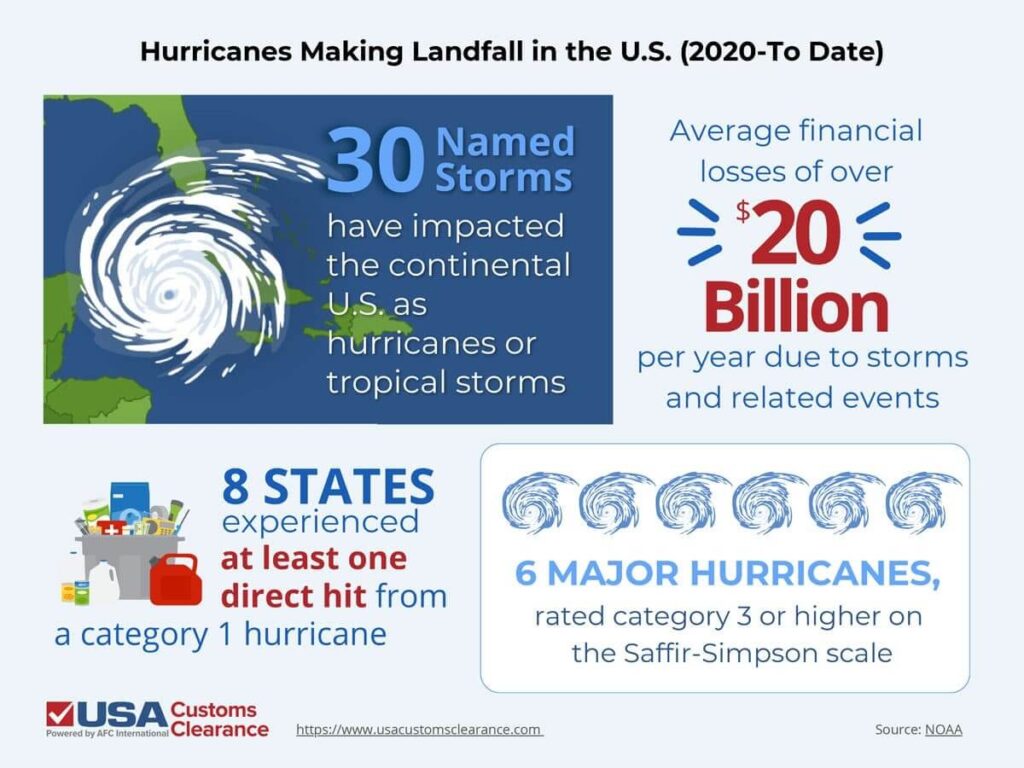



The ability to transport materials and supplies is critical before and after storms. A quick look at any of the recent hurricane seasons is proof of how badly weather can affect transportation services and hamper relief and recovery efforts.
Key Takeaways:
We’ll go over the largest hurdles you’re likely to face and how they impact freight shipping and local logistics.
A business operating in regions prone to certain major climate events and disasters doesn’t have the luxury of only planning if something happens. They need to have a set plan for when something will happen.
If we measure events in terms of widespread damage, recent years have shown that hurricanes, wildfires, and even harsh winters have the ability to cause billions of dollars in damage and displace thousands, sometimes millions of people at a time.
The areas of the country most prone to wildfires in recent years include much of California and the Pacific Northwest, including regions of Idaho and Montana. These are often heavily forested areas where a stray lighting strike can start a fire at random, especially during persistent drought conditions.
While these fires can (and have) destroyed entire towns and burned through millions of acres at a time, most occur in fairly rural areas. Of course, related effects, such as falling ash, can have widespread effects in nearby urban centers, causing delays in local services related to shipping and transportation.
Winter may be something that comes along every year, but the severity and location can still take some by surprise. Heavy snow and ice can bring critical transport systems to a screeching halt.
Ice can make roads treacherous to drive on, especially for big rigs with heavy loads, and an unexpected deep freeze can damage critical infrastructure such as water pipes.
Areas in the Midwest and Northeast that are used to getting such weather tend to fare better. However, in February 2021, we saw how such an event caused widespread damage in Texas and other Southern states that were ill-equipped for it. A hard freeze lasting just over a week caused power outages and shut down a number of important shipping lanes.
Thanks to ever advancing technology, we have a better understanding than ever before of when and where hurricanes will form and potentially impact. However, when compared to an event such as a wildfire, these massive storms are far more disruptive over a greater area.
First, hurricanes are huge, on average spanning about 300 miles in width. Although the intensity will vary greatly across that span, the point is that it has the potential to impact a large area all at once. Chances are, at least some of that area will be heavily populated.
Never has this been more true than in recent years. People and businesses along the South Atlantic coast and bordering the Gulf of Mexico have experienced an increasing number of intense systems. Records maintained by the National Oceanic & Atmospheric Administration (NOAA) reveal the following.

Secondly, the effect of these storms goes far beyond the initial impact. It’s not just rain and wind that people and businesses have to consider. Hurricanes also bring about:
These are just the weather phenomenon. Ultimately, these end up impacting infrastructure and people in potentially catastrophic ways.
Simply put, if you need to move anything before or after a storm is set to impact your area, be prepared for various delays.
Severe weather will disrupt all manner of transportation. Some will be due to the direct impact and aftermath of the storm, but also because of the greater movement of people due to emergency evacuations or mobilizations of emergency services.
Among the many issues that come up are:
As you can imagine, these issues directly impact a business financially. From managing product loss to potentially losing customers, a lack of transportation options has wide-reaching consequences.
Related: Supply Chain Continuity: Manage Disruptions and Alternatives
Since secure transportation, or a lack of it, is so vital to business, having a specific plan that focuses on transportation needs is a must. This isn’t just for the well-being of your business, but also for the safety of those working for you.
When starting a disaster preparedness plan, consider the following in regard to transportation:
Taking these factors into account can help you plan ahead and avoid over- or under-reacting to a situation. Every state and region is different.
Are you in a valley? The effects of Hurricane Helene reminded us that flooding is a very real threat. It will keep vehicles from moving in or out. Is your inventory meant as a supply for before or after the storm? If you’re renting out heavy equipment or temporary storage, make sure that it finds a safe staging area outside the expected impact zone.
Finally, if you know that moving things is the only way to save your inventory, make sure you put plans into effect as soon as possible. Many logistics providers will work around the clock to help out businesses during critical times, but getting in early gives you the best chance of navigating the situation successfully.
Related: Hurricane Preparation for Business
At Emergency Management Logistics, we understand how devastating weather disruptions can be to your supply chain. Whether it’s transportation services or temporary warehousing needs, we offer these time-critical services to keep your business running.
Whether you’re looking to plan ahead or still reeling from the latest disaster, we have something to offer you.
Reach out to us for help at (855) 420-9447 or complete an online contact form now.
For those looking to plan ahead for the next big one, consider scheduling a consultation to discuss your disaster preparedness plan.